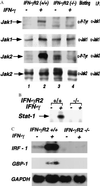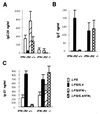Targeted disruption of the interferon-gamma receptor 2 gene results in severe immune defects in mice
- PMID: 9653170
- PMCID: PMC20959
- DOI: 10.1073/pnas.95.14.8233
Targeted disruption of the interferon-gamma receptor 2 gene results in severe immune defects in mice
Abstract
To study the role of the interferon- (IFN) gammaR2 chain in IFN-gamma signaling and immune function, IFN-gammaR2-deficient mice have been generated and characterized. Cells derived from IFN-gammaR2 -/- mice are unable to activate either JAK/STAT signaling proteins or gene transcription in response to IFN-gamma. The lack of IFN-gamma responsiveness alters IFN-gamma-induced Ig class switching by B cells from these mice. In vitro cultures of T cells demonstrate that the T cells from the IFN-gammaR2 -/- mice have a defect in Th1 cell differentiation. The IFN-gammaR2 (-/-) mice also produce lower amounts of IFN-gamma in response to antigenic challenge. In addition, IFN-gammaR2 -/- mice are defective in contact hypersensitivity and are highly susceptible to infection by Listeria monocytogenes. These results demonstrate that the IFN-gammaR2 is essential for IFN-gamma-mediated immune responses in vivo.
Figures





Similar articles
-
Interferon gamma signaling alters the function of T helper type 1 cells.J Exp Med. 2000 Oct 2;192(7):977-86. doi: 10.1084/jem.192.7.977. J Exp Med. 2000. PMID: 11015439 Free PMC article.
-
Regulation of IFN-gamma signaling is essential for the cytotoxic activity of CD8(+) T cells.J Immunol. 2001 Nov 15;167(10):5574-82. doi: 10.4049/jimmunol.167.10.5574. J Immunol. 2001. PMID: 11698428 Free PMC article.
-
Phosphorylation-Mediated IFN-γR2 Membrane Translocation Is Required to Activate Macrophage Innate Response.Cell. 2018 Nov 15;175(5):1336-1351.e17. doi: 10.1016/j.cell.2018.09.011. Epub 2018 Oct 11. Cell. 2018. PMID: 30318148
-
The interferon gamma (IFN-gamma) receptor: a paradigm for the multichain cytokine receptor.Cytokine Growth Factor Rev. 1997 Sep;8(3):189-206. doi: 10.1016/s1359-6101(97)00009-9. Cytokine Growth Factor Rev. 1997. PMID: 9462485 Review.
-
[Disorders of interferon-gamma activation pathways: new group of primary immune deficiency diseases].Orv Hetil. 2001 Nov 18;142(46):2557-61. Orv Hetil. 2001. PMID: 11770174 Review. Hungarian.
Cited by
-
Interferon-lambda: a new addition to an old family.J Interferon Cytokine Res. 2010 Aug;30(8):555-64. doi: 10.1089/jir.2010.0078. J Interferon Cytokine Res. 2010. PMID: 20712453 Free PMC article. Review.
-
Critical role of the endogenous interferon ligand-receptors in type I and type II interferons response.Immunology. 2014 Jul;142(3):442-52. doi: 10.1111/imm.12273. Immunology. 2014. PMID: 24597649 Free PMC article.
-
Memory CD4+ T cells: fate determination, positive feedback and plasticity.Cell Mol Life Sci. 2012 May;69(10):1577-83. doi: 10.1007/s00018-012-0966-9. Epub 2012 Apr 6. Cell Mol Life Sci. 2012. PMID: 22481436 Free PMC article. Review.
-
Gadd45 beta and Gadd45 gamma are critical for regulating autoimmunity.J Exp Med. 2005 Nov 21;202(10):1341-7. doi: 10.1084/jem.20051359. Epub 2005 Nov 14. J Exp Med. 2005. PMID: 16287712 Free PMC article.
-
Epitope-specific regulation of immunoglobulin class switching in mice immunized with malarial merozoite surface proteins.Infect Immun. 2005 Dec;73(12):8119-29. doi: 10.1128/IAI.73.12.8119-8129.2005. Infect Immun. 2005. PMID: 16299306 Free PMC article.
References
-
- Farrar M A, Schreiber R D. Annu Rev Immunol. 1993;11:571–611. - PubMed
-
- Pestka S, Langer J A, Zoon K C, Samuel C E. Annu Rev Biochem. 1987;56:727–777. - PubMed
-
- Pestka S, Kotenko S V, Muthukumaran G, Izotova L S, Cook J R, Garotta G. Cytokine Growth Factor Rev. 1997;8:189–206. - PubMed
-
- Bach E A, Aguet M, Schreier R D. Annu Rev Immunol. 1997;15:563–591. - PubMed
Publication types
MeSH terms
Substances
Grants and funding
LinkOut - more resources
Full Text Sources
Other Literature Sources
Medical
Molecular Biology Databases

